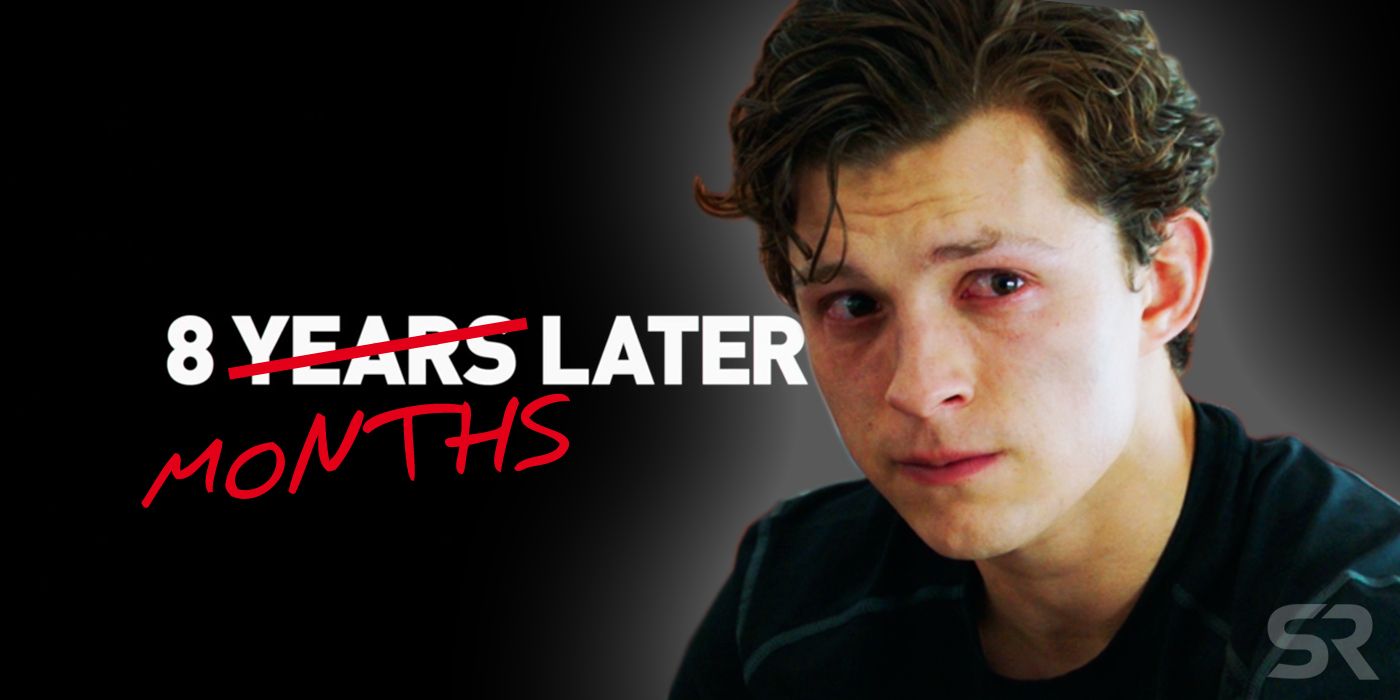Spider-Man: Far From Home somehow manages to make the Marvel movie timeline even more complicated. As impressive a feat of episodic storytelling the MCU has proven to be over the past decade, the films' timeline is notorious for its inconsistencies under greater scrutiny. These aren't always plot holes or major narrative inconsistencies (those exist, but are usually addressed retroactively by post-credits scenes or, once upon a time, short films). Rather, it's how the movies slot together based on smaller details.
Perhaps the most egregious example is Spider-Man: Homecoming claiming it was set "eight years later" from the events of The Avengers, despite the accepted timeline placing it just four years after. While there is an explanation for why this happened - it was necessary to have Liz Allen be a younger child in 2012 - it still doesn't make sense, and was effectively retconned by Avengers: Infinity War.
Now, what happens with Spider-Man: Far From Home is nowhere near as glaring or egregious. Instead of being an inexplicable mistake, it's the build-up of timeline leaps that have been made over the past year of Marvel films finally buckling under their own weight. As we wrote following the release of Avengers: Endgame, that film's five-year time jump to 2023 leaves some major ramifications for a radically different world. And as much as Far From Home deals with the Blip in a suitable manner, it can't quite make everything fit.
Now, it's worth stating at this point that these sort of timeline issues aren't really a problem with the MCU. Marvel movies typically slot together well on a broad narrative and character level, with setting and micro-continuity a secondary concern. And when we're dealing with big picture action, that ultimately leads to better films; nobody's wanting to have a whole movie dealing with correcting these issues. Still, when considering the cohesion of the MCU, they're always worth discussing - especially when, in the case of Spider-Man: Far From Home, it leaves things drastically different without even a cursory glance.
Spider-Man: Far From Home Is Set In 2024, Not 2023
Here's where we're at before Spider-Man: Far From Home. Avengers: Infinity War takes place in 2018 (Tony Stark says Thanos' attack comes six years since The Avengers, which multiple movies place in 2012), more specifically spring of that year. Endgame picks up straight after, then jumps forward five years to some point in 2023, and comes to a close a few days/weeks/months later (depending on how long it takes to perfect time travel but still in 2023). This is when all the snap victims return, setting the stage for Spider-Man's new movie.
Far From Home takes place the summer after the Blip victims return. Photographs of Peter Parker's passport in trailers suggested the trip was in July, and while the specific shots were absent from the finished film, they're likely to appear in upcoming short film "Peter's List" and so we can assume as canon. Crucially, we learn in the student news report at Midtown High that this is eight months after Endgame and, additionally, Betty's on-air complaint confirms she and the rest of Peter's class had taken midterms before the Blip but had to retake them after returning).
With Spider-Man: Far From Home set in July, that places the end of Avengers: Endgame's ending in November of the previous year. With Infinity War locked into May 2018, that means Avengers: Endgame takes place over a period of several months in 2023, nearing half a year. By extension, that means Spider-Man: Far From Home takes place in Summer 2024, not the widely reported 2023.
While that's rather inconsequential by itself, it has a pretty major implication for Marvel storytelling going forward. After Endgame, it was widely expected that Spider-Man: Far From Home and other upcoming, non-prequel MCU films would be set in 2023. What this new move does is push the entire schedule a year later, giving the MCU even longer to catch up with itself.
Spider-Man: Far From Home Rectons The Snap, Makes Its Effects Last 5.5 Years
What's so striking is how rigid the MCU timeline is here. Avengers: Infinity War must be set in Spring 2018, Avengers: Endgame over half a year ending in late 2023, and thus Spider-Man: Far From Home in Summer 2024. And that new Avengers: Endgame stretch has a strange side effect that reframes our understanding of the Blip and its aftermath. Assuming a July setting for Spider-Man: Far From Home, then Avengers: Endgame ends in November of the previous year, five-and-a-half years after Avengers: Infinity War. That stretches the amount of time the snap victims were absent for, and means they were inserted in a random part of the year.
There's no real workaround for either of these points - Far From Home is locked eight months after Endgame by dialogue in the movie, while Avengers 4 positions itself five years after Infinity War, which puts itself in 2018. While that "five years" could be rounded down to 4.5 years or up to 5.5 years, thus starting in late 2022 or late 2023, it's not that easy. If the time jump was 4.5 years, then Endgame would pick up in late 2022, at the earliest December, but even if everything that happened - time travel, Thanos, un-Blipping - was in the space of a couple of days, the eight-month gap would push the Far From Home trip into August, which doesn't fit due to the movie opening during term time. There's a converse issue with rounding up to 5.5, meaning we're locking 2023 and 2024 for the final two movies of Phase 3, respectively.
Peter Parker Is 16 For 17 Months
All of that is weird and doesn't quite match what is widely accepted about the post-Endgame MCU, but nothing actively breaks... yet. Unfortunately, things don't hold true if you take a look at the high-schooler at the center of it all.
First, let's handle Peter Parker's school years. Captain America: Civil War is set in June 2016 and introduces Spider-Man as a Freshman (school year 15/16). In Spider-Man: Homecoming, set a few months later Fall 2016 (ignore any "eight years later" claims), has him starting his Sophomore year (16/17). Avengers: Infinity War takes place in early 2018, near the end of Peter's Junior year (17/18). He's Blipped and returns in late 2023 in Avengers: Endgame, then restarts his Junior year midway through (23/24), which is coming to a close by the Summer 2024 events of Spider-Man: Far From Home.
That's pretty by-the-by, all things considered for a world with a Mad Titan. The wrinkle is Peter Parker's age. In the comics, his birthday is in September or October (he's a Libra), but the movies have rarely translated those. Far From Home trailers showed Peter's passport with his birthdate as August 10, albeit without a birth year. While that is primarily a reference to his comic debut (Amazing Fantasy #15 hit newsstands on August 10, 1962) and is open to change, it matches most of what's explicitly stated about Spider-Man's age.
In Homecoming, Peter says he's 15, meaning in Civil War he was either 14 or 15. Then, in Spider-Man: Far From Home, Peter says to Mysterio he's 16 when offered a beer. And already we have an issue. Peter will have turned 16 later on in the Sophomore year started in Homecoming, and must have remained so throughout his Junior year until the events of Avengers: Infinity War. But then, when coming back from the Blip at 16-going-on-17, he had another eight months of being a Junior at 16. Assuming everything laid out so far and that Peter's Birthday is August (i.e. after the events of Far From Home), he's been 16 for seventeen months; the Blip skipped over a birthday but he's still counting directly.
Why Spider-Man: Far From Home Makes This Mistake
The age of Blip victims is something Spider-Man: Far From Home does address, but only in the aging up of the survivors. How returning mid-year changes thing is referenced by Betty only in passing to justify keeping the class as Juniors. Otherwise, it's basically assumed that everybody who disappeared kept their birthday date and celebrates it six months out of sync.
This is the result of the brazen choice on Avengers: Endgame's part to have the MCU jump forward in time yet spend exactly no time exploring any of the ramifications. Because Spider-Man: Far From Home sets itself so long after Avengers: Endgame to reach summer, it must move itself into a new year and strech the Blip as a result, yet doesn't account for any age differences. Essentially, the root issue is taking a movie where the story, for the most part, has no direct connection to Endgame's fallout but making it fit anyway. It's a minor, but nevertheless endemic, result of continuous shared universe filmmaking.
That's not to say this is unavoidable. As with Homecoming, the real issue is the arbitrary use of "eight". There does need to be a time jump to get the Midtown students to summer for their vacation, but if it was just a couple of months, it could be argued that all of Avengers: Endgame took place in early 2023: Far From Home could fit into the same year, the Blip would be around five years, and Peter Parker would be 16 by any logical measurement. Or, even simpler, the Spider-Man: Far From Home script didn't need to have Peter say his exact age for the underage drinking joke at all.





